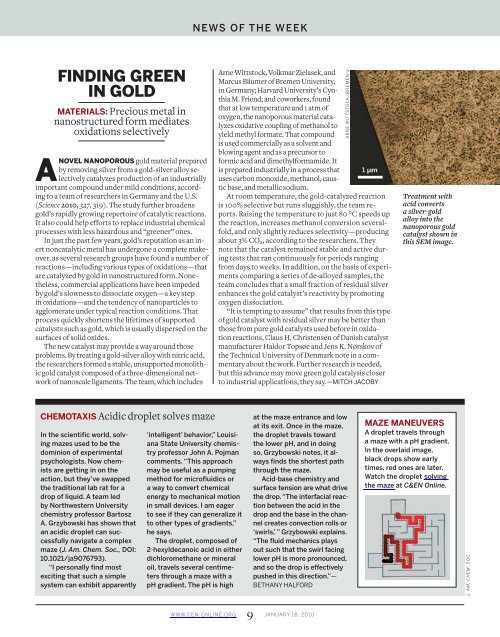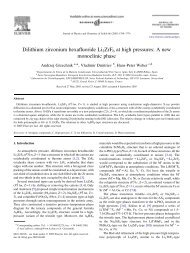Chemical & Engineering News Digital Edition - January 18, 2010
Chemical & Engineering News Digital Edition - January 18, 2010
Chemical & Engineering News Digital Edition - January 18, 2010
You also want an ePaper? Increase the reach of your titles
YUMPU automatically turns print PDFs into web optimized ePapers that Google loves.
FINDING GREEN<br />
IN GOLD<br />
MATERIALS: Precious metal in<br />
nanostructured form mediates<br />
oxidations selectively<br />
A<br />
NOVEL NANOPOROUS gold material prepared<br />
by removing silver from a gold-silver alloy selectively<br />
catalyzes production of an industrially<br />
important compound under mild conditions, according<br />
to a team of researchers in Germany and the U.S.<br />
( Science <strong>2010</strong>, 327, 319). The study further broadens<br />
gold’s rapidly growing repertoire of catalytic reactions.<br />
It also could help efforts to replace industrial chemical<br />
processes with less hazardous and “greener” ones.<br />
In just the past few years, gold’s reputation as an inert<br />
noncatalytic metal has undergone a complete makeover,<br />
as several research groups have found a number of<br />
reactions—including various types of oxidations—that<br />
are catalyzed by gold in nanostructured form. Nonetheless,<br />
commercial applications have been impeded<br />
by gold’s slowness to dissociate oxygen—a key step<br />
in oxidations—and the tendency of nanoparticles to<br />
agglomerate under typical reaction conditions. That<br />
process quickly shortens the lifetimes of supported<br />
catalysts such as gold, which is usually dispersed on the<br />
surfaces of solid oxides.<br />
The new catalyst may provide a way around those<br />
problems. By treating a gold-silver alloy with nitric acid,<br />
the researchers formed a stable, unsupported monolithic<br />
gold catalyst composed of a three-dimensional network<br />
of nanoscale ligaments. The team, which includes<br />
CHEMOTAXIS Acidic droplet solves maze<br />
In the scientific world, solving<br />
mazes used to be the<br />
dominion of experimental<br />
psychologists. Now chemists<br />
are getting in on the<br />
action, but they’ve swapped<br />
the traditional lab rat for a<br />
drop of liquid. A team led<br />
by Northwestern University<br />
chemistry professor Bartosz<br />
A. Grzybowski has shown that<br />
an acidic droplet can successfully<br />
navigate a complex<br />
maze ( J. Am. Chem. Soc., DOI:<br />
10.1021/ja9076793).<br />
“I personally find most<br />
exciting that such a simple<br />
system can exhibit apparently<br />
NEWS OF THE WEEK<br />
‘intelligent’ behavior,” Louisiana<br />
State University chemistry<br />
professor John A. Pojman<br />
comments. “This approach<br />
may be useful as a pumping<br />
method for microfluidics or<br />
a way to convert chemical<br />
energy to mechanical motion<br />
in small devices. I am eager<br />
to see if they can generalize it<br />
to other types of gradients,”<br />
he says.<br />
The droplet, composed of<br />
2-hexyldecanoic acid in either<br />
dichloromethane or mineral<br />
oil, travels several centimeters<br />
through a maze with a<br />
pH gradient. The pH is high<br />
Arne Wittstock, Volkmar Zielasek, and<br />
Marcus Bäumer of Bremen University,<br />
in Germany; Harvard University’s Cynthia<br />
M. Friend; and coworkers, found<br />
that at low temperature and 1 atm of<br />
oxygen, the nanoporous material catalyzes<br />
oxidative coupling of methanol to<br />
yield methyl formate. That compound<br />
is used commercially as a solvent and<br />
blowing agent and as a precursor to<br />
formic acid and dimethylformamide. It<br />
is prepared industrially in a process that<br />
uses carbon monoxide, methanol, caustic<br />
base, and metallic sodium.<br />
At room temperature, the gold-catalyzed reaction<br />
is 100% selective but runs sluggishly, the team reports.<br />
Raising the temperature to just 80 °C speeds up<br />
the reaction, increases methanol conversion severalfold,<br />
and only slightly reduces selectivity—producing<br />
about 3% CO 2 , according to the researchers. They<br />
note that the catalyst remained stable and active during<br />
tests that ran continuously for periods ranging<br />
from days to weeks. In addition, on the basis of experiments<br />
comparing a series of de-alloyed samples, the<br />
team concludes that a small fraction of residual silver<br />
enhances the gold catalyst’s reactivity by promoting<br />
oxygen dissociation.<br />
“It is tempting to assume” that results from this type<br />
of gold catalyst with residual silver may be better than<br />
those from pure gold catalysts used before in oxidation<br />
reactions, Claus H. Christensen of Danish catalyst<br />
manufacturer Haldor Topsøe and Jens K. Nørskov of<br />
the Technical University of Denmark note in a commentary<br />
about the work. Further research is needed,<br />
but this advance may move green gold catalysis closer<br />
to industrial applications, they say. —MITCH JACOBY<br />
at the maze entrance and low<br />
at its exit. Once in the maze,<br />
the droplet travels toward<br />
the lower pH, and in doing<br />
so, Grzybowski notes, it always<br />
finds the shortest path<br />
through the maze.<br />
Acid-base chemistry and<br />
surface tension are what drive<br />
the drop. “The interfacial reaction<br />
between the acid in the<br />
drop and the base in the channel<br />
creates convection rolls or<br />
‘swirls,’ ” Grzybowski explains.<br />
“The fluid mechanics plays<br />
out such that the swirl facing<br />
lower pH is more pronounced,<br />
and so the drop is effectively<br />
pushed in this direction.” —<br />
BETHANY HALFORD<br />
WWW.CEN-ONLINE.ORG 9 JANUARY <strong>18</strong>, <strong>2010</strong><br />
ARNE WITTSTOCK/BREMEN U<br />
Treatment with<br />
acid converts<br />
a silver-gold<br />
alloy into the<br />
nanoporous gold<br />
catalyst shown in<br />
this SEM image.<br />
MAZE MANEUVERS<br />
A droplet travels through<br />
a maze with a pH gradient.<br />
In the overlaid image,<br />
black drops show early<br />
times, red ones are later.<br />
Watch the droplet solving<br />
the maze at C&EN Online .<br />
J. AM. CHEM. SOC.




